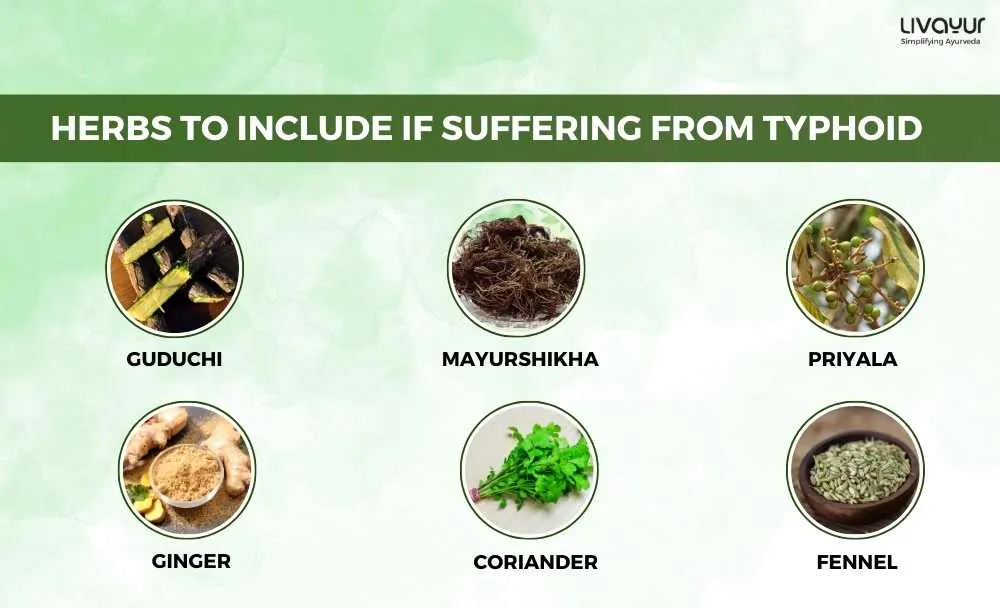
Ayurveda is one of the venerable measures of holistic well-being that emphasizes the intrinsic connection between diet, health, and harmony within the body. Typhoid, a bacterial infection that predominantly affects the digestive system, highlights the significance of nutrition in the healing process.
This article takes an Ayurvedic perspective on the “typhoid diet” – a dietary regimen that addresses the symptoms of typhoid fever and aligns with the principles of Ayurveda to promote a sustainable path to recovery. So, let’s understand how these dietary measures can guide you toward optimal health and rejuvenation.
What is typhoid?
Typhoid, known as “jwara” in the ancient healing system of Ayurveda, is an ailment that manifests with implications for the human system as a whole. Ayurveda recognizes jwara as one of the most potent disorders, as it influences the physical body, the senses, and the mind.
This pervasive impact can be due to aberrations in the rasavahasrotas (the channels of nutrient circulation) and manavahasrotas (the channels of mental and sensory functions). Understanding typhoid through Ayurveda provides insights into its holistic impact and paves the way for comprehensive management strategies rooted in ancient wisdom. [1]
Typhoid diet: What to eat
In Ayurveda, dietary choices are pivotal in maintaining health and restoring balance in times of illness. Adhering to a well-thought-out diet is crucial in the healing process when managing typhoid. From an Ayurvedic standpoint, here’s a guide on what to eat during a typhoid episode.
1. Easy-to-digest foods
During typhoid, the digestive system is particularly vulnerable. Opt for easily digestible foods such as rice gruel (congee), khichdi (a blend of rice and lentils), and cooked vegetables. These gentle foods help to nourish the body without overburdening the digestive fire (agni). [2]
2. Herbal decoctions
Include herbal concoctions, like ginger or coriander-cumin-fennel (CCF), into your diet. These infusions aid digestion, reduce inflammation, and provide essential hydration to the body. [2]
3. Liquids and broths
Stay well-hydrated with warm, soothing liquids like vegetable soups and herbal teas. These help maintain electrolyte balance and alleviate fever-related discomfort. [2]
4. Cooked fruits
Fresh fruits are usually avoided during typhoid due to their fiber content, which can be harsh on the delicate digestive system. However, cooked fruits like applesauce can provide essential vitamins and minerals without causing digestive distress. [3]
5. Ayurvedic herbs
Ayurvedic herbs like guduchi, mayurshikha, and priyala can help manage the condition. Consult an Ayurvedic practitioner for guidance on incorporating these herbs into your diet or treatment plan. [4]
6. Mindful eating
Ayurveda places great emphasis on mindful eating. Consume your meals in a calm and peaceful environment, focusing on your food and chewing it thoroughly to aid digestion.
What to avoid during typhoid
When combating typhoid, it is equally essential to be mindful of what not to consume, as certain foods and habits can exacerbate the symptoms and hinder healing. Here, we elucidate the dietary and lifestyle factors to avoid during a typhoid episode from an Ayurvedic standpoint.
1. Raw, uncooked foods
One of the primary principles of Ayurveda is that raw, uncooked foods are generally harder to digest. During typhoid, when the digestive fire (agni) remains compromised, avoid raw vegetables and fruits, as they may be difficult for the weakened digestive system to process. [2]
2. Spicy and heavy foods
Avoid spices and heavy, greasy foods, as they aggravate the disturbed digestive balance. These include spicy curries, deep-fried items, and decadent desserts. [2]
3. Cold and icy beverages
Cold beverages and ice-cold water can weaken the digestive fire further. Consuming liquids at room temperature or slightly warm to support digestion is advisable. [5]
4. Acidic foods
Acidic foods like citrus fruits and tomatoes may irritate the sensitive gastrointestinal tract. Avoid these until symptoms subside. [2]
5. Irregular eating patterns
Irregular meal timings and skipping meals can disrupt the body’s natural rhythms and hinder recovery. Aim for regular, nourishing meals at consistent intervals.
6. Stress and overexertion
Mental and physical stress can further weaken the immune system. Resting adequately and engaging in stress-reduction techniques such as meditation and gentle yoga is advisable. [6]
Symptoms of typhoid [7]
Typhoid evolves gradually and hence, there are a few symptoms that can let you know if a person is suffering from typhoid or not. They’re as follows:
- Early gastrointestinal distress, stomach upsets, loose motions, stomach aches or constipation
- Rising and falling fever, recurring fever
- A throbbing headache
- Sore throat
- Muscle and joint pain
- Extreme Tiredness
Importance of a diet in typhoid
Time and time, it has been proven that poor nutrition can aggravate typhoid fever and make conditions worse for the patient. The human body goes through so much while suffering from typhoid, from headache and stomach ache to fever, furthering into general fatigue or exhaustion. This is also the reason why Ayurveda classifies typhoid as ‘Visham Jwara.’ [1]
During these difficult times, the body needs nutrition. One must never deprive a person suffering from typhoid of a balanced, wholesome diet. A more liberal, more hygienic, and easily digestible diet is the key to getting healthy, in typhoid. [2][8]
FAQs
1. What is a typhoid diet chart?
A diet chart for a typhoid patient is a structured dietary plan for individuals suffering from typhoid fever. It outlines the types of foods to include and avoid during the illness, considering the patient’s weakened digestive system and overall health condition. The goal of a typhoid diet chart is to provide nourishment and support the immune system.
2. What is the best diet for a typhoid patient?
The best diet for a typhoid patient is gentle on the digestive system, easy to digest, and packed with essential nutrients. Avoiding spicy, heavy, raw foods and cold beverages to prevent exacerbating symptoms is necessary. An Ayurvedic practitioner can provide personalized dietary recommendations based on the patient’s constitution and specific symptoms.
3. What is a typhoid fever diet?
The typhoid fever diet is a specialized dietary regimen to support individuals afflicted with typhoid fever. This diet typically comprises easily digestible, nourishing foods, well-cooked vegetables, and herbal teas. Avoiding spicy, heavy, and raw foods is crucial during this period to prevent digestive distress. Adequate hydration with warm fluids is also emphasized to maintain electrolyte balance.
4. What is the best Indian diet for typhoid patients?
An Indian typhoid food diet for a typhoid patient considers the cultural and culinary preferences of individuals in India. It aligns with the principles of the typhoid diet, emphasizing easily digestible, well-cooked foods and herbal infusions. The diet avoids spicy and heavy Indian dishes that may burden the digestive system.
5. What are typhoid precautions and diet?
In addition to dietary considerations, typhoid precautions involve maintaining proper hygiene, drinking clean and safe water, and practicing hand hygiene to prevent the spread of the infection. The diet should align with the principles of the typhoid diet, emphasizing easily digestible, hygienically prepared foods to support the healing process.
Conclusion
The Ayurvedic approach to the typhoid diet provides valuable insights into the intricate relationship between nutrition, health, and holistic well-being. Adhering to Ayurvedic principles will help individuals effectively navigate the challenges of typhoid while promoting their body’s healing processes.
It is essential to prioritize easily digestible foods and cooked vegetables, which nourish the weakened digestive system without taxing it. Herbal teas and warm fluids can help maintain hydration and alleviate discomfort. Equally important is avoiding spicy, heavy, and raw foods and cold beverages to prevent worsening symptoms.
For personalized dietary recommendations, seeking guidance from an Ayurvedic practitioner, considering one’s constitution and specific imbalances, is highly advisable. Implementing these insights and respecting the wisdom of Ayurveda will help promote a more balanced recovery from typhoid.
Disclaimer
The information provided here does not intend to replace professional advice or treatment. Please consult a medical practitioner in case of any illness.
References
- AYURVEDIC MANAGEMENT OF VISHAM JWARA (TYPHOID) IN SUTIKA.
- The Diet in Typhoid Fever.
- ACUTE INTESTINAL INFECTIONS
- OVERVIEW OF FOLK MEDICINE USED FOR TYPHOID IN INDIA
- Prevention Tips for Travelers
- Psychological Stress and the Human Immune System: A Meta-Analytic Study of 30 Years of Inquiry
- Symptoms -Typhoid fever
- Typhoid Fever
















